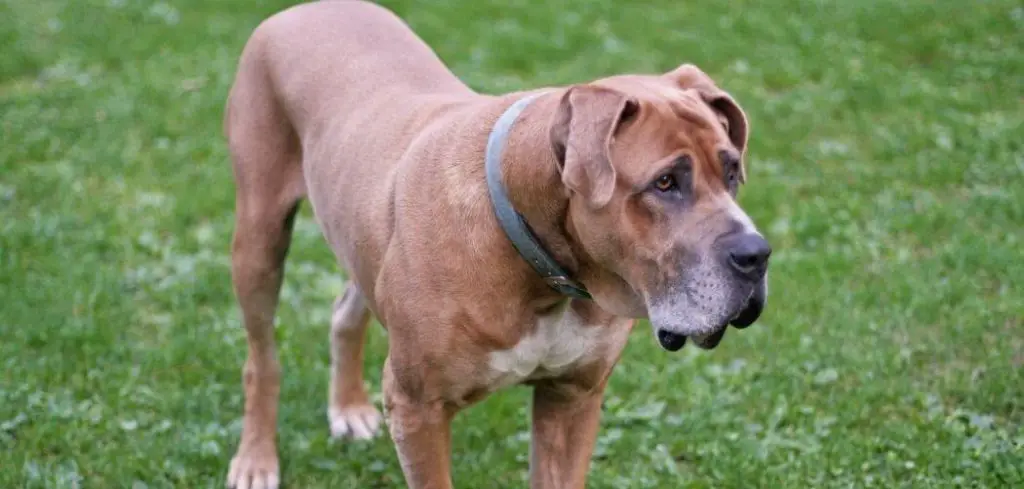Losing weight and muscle mass in an old dog can signal underlying health issues that require attention. While some gradual changes are normal with aging, rapid or noticeable loss often indicates health problems.
We outline the common causes of weight and muscle loss in old dogs, what you can do at home, and when to seek veterinary help.
Old Dog Losing Weight and Muscle Mass — Why It Happens
Old dogs may lose weight and muscle mass due to a combination of age-related changes and underlying health issues. As dogs age, their metabolism slows and they naturally lose muscle tone, but significant or rapid weight and muscle loss is often linked to problems such as dental disease (making it painful to eat), chronic illnesses like kidney or liver disease, diabetes, cancer, or malnutrition from not absorbing nutrients properly. Arthritis or reduced mobility can also contribute, since less activity accelerates muscle loss.

Old Dog Losing Weight and Muscle Mass: Common Causes
Age-Related Muscle Loss (Sarcopenia)
As dogs age, natural muscle loss, or sarcopenia, becomes common. Older dogs may lose strength and tone even without changes in activity or diet.
Signs include thinner limbs, reduced stamina, and difficulty rising or climbing stairs. While part of normal aging, sarcopenia can worsen if combined with reduced nutrition or chronic illness, leading to decreased mobility and quality of life.
Read more: Old Dog Losing Weight (What it means)
Reduced Appetite
Older dogs may eat less due to dental discomfort, decreased sense of smell, or changes in metabolism.
Reduced food intake results in gradual weight and muscle loss. You might notice selective eating, dropping food, or reluctance to eat certain textures.
Persistent appetite loss is concerning because it can lead to malnutrition, further muscle wasting, and weakened immunity.
Chronic Illness
Conditions such as kidney disease, liver disease, diabetes, or cancer often cause unexplained weight and muscle loss.
These illnesses interfere with nutrient absorption, increase metabolism, or reduce appetite. Signs may include lethargy, vomiting, diarrhea, increased thirst, or behavioral changes.
Detecting chronic illness early is critical for treatment and maintaining your dog’s strength.
Hormonal Disorders
Hypothyroidism or Cushing’s disease can contribute to muscle wasting and weight changes in senior dogs.
Hypothyroidism slows metabolism and may cause hair loss, lethargy, and weakness.
Cushing’s disease often causes muscle thinning, increased appetite, and abdominal enlargement. Early detection allows for medical management that can stabilize weight and muscle mass.
Malabsorption or Digestive Problems
Gastrointestinal issues like inflammatory bowel disease, exocrine pancreatic insufficiency, or food sensitivities prevent proper nutrient absorption.
Dogs with malabsorption may lose weight and muscle despite eating normally.
Signs include diarrhea, greasy stools, bloating, and flatulence. Untreated malabsorption can lead to severe nutrient deficiencies and further muscle wasting.
Arthritis and Reduced Activity
Painful joints or mobility issues may reduce a dog’s activity levels, leading to muscle atrophy. Even if the dog maintains appetite, lack of movement prevents muscle maintenance.
Owners might notice reluctance to walk, climb stairs, or play. Maintaining safe, low-impact exercise is essential to preserve muscle and overall health.
What to Do If Your Old Dog Is Losing Weight and Muscle Mass
Start by monitoring your dog’s weight, muscle tone, and eating habits regularly. Tracking these changes helps your veterinarian identify trends and potential causes.
Ensure a balanced, senior-appropriate diet rich in high-quality protein to support muscle maintenance. Some dogs may benefit from nutritional supplements or special formulations recommended by a veterinarian.
Encourage gentle, low-impact exercise to preserve muscle mass without causing pain. Short walks, controlled play, or swimming can help maintain strength.
Address dental care and oral health issues promptly, as pain can reduce food intake. Brushing teeth, dental chews, or professional cleanings improve comfort and appetite.
Consult your vet for routine screenings for chronic illnesses or hormonal disorders. Early diagnosis and treatment can prevent further weight and muscle loss and improve your dog’s quality of life.
When to Call or Visit Your Vet
Contact your veterinarian immediately if weight loss is rapid, your dog shows signs of weakness, or you notice changes in appetite or behavior.
If your dog experiences vomiting, diarrhea, excessive thirst, or urination alongside muscle loss, these may indicate serious underlying illness that requires prompt evaluation.
Persistent fatigue, difficulty walking, or noticeable changes in posture should be addressed by your vet to assess joint health, muscle strength, and overall wellness.
Early intervention is crucial, as untreated weight and muscle loss can compromise immunity, mobility, and organ function.
Read more: Old Dog Losing Hair (How to spot concerning changes)
Key Takeaway
Weight and muscle loss in an old dog can stem from age-related changes, reduced appetite, chronic illness, hormonal imbalances, digestive problems, or reduced activity.
Monitoring your dog’s body condition, maintaining proper nutrition, encouraging safe exercise, and seeking veterinary care for underlying conditions are essential steps to preserve strength and quality of life.
Early recognition and intervention help ensure your senior dog stays healthy, strong, and comfortable in their later years.
